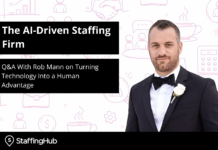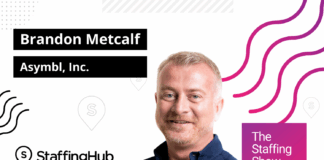
The nature of work is changing, according to a survey released by Ceridian. Record-low unemployment numbers partnered with the rise of automation and artificial intelligence, among other factors, have led to changing roles and shifting work environments. Organizations have been struggling with navigating this change, but this could be the perfect opportunity for them to shape their future.
Ceridian partnered with Hanover Research to release “The 2020 Future of Work Report” after surveying 999 professionals from the U.S. (71%) and Canada (29%) who worked for companies with more than 1,000 employees. Many company leaders expressed trepidation when looking ahead to the future of their industry, with technology as a main component behind many of these changes.
Moving forward with technology
Most organizations viewed the rapid advancement of technology as a challenge instead of a transformational opportunity. Half of survey respondents said rapid technological advancement was one of the top three challenges of the modern workforce, alongside increasing compliance and regulatory complexity (55%) and a shortage of skilled talent (50%).
While over half of decision-makers said they planned to adopt advanced technologies (55%) and cognitive technologies (53%) in the next two years, many leaders weren’t focused on shifting their mindset when it comes to adapting to technologies.
“Tech development is a struggle, but also an opportunity,” said Holger Mueller, Constellation Research VP and principal analyst. “It’s unfortunate that it’s perceived as negative because it’s also an enabler.”
Addressing skills gaps
Almost half (45%) of survey respondents said they are experiencing a skills gap, and 29% said they’re experiencing a general labor shortage. Over half (63%) said they anticipate a skills gap within their industry during the next two years.
When it comes to job skill requirements, most respondents said these will also change in the next two years. The majority (81%) said they will automate certain job functions, and 80% said they will need more employees with technical skills.
Companies are proactively trying to address skills gaps by planning to re-skill their existing workforce (74%) and investing in succession planning (71%). An untapped resource for addressing these concerns appears to be partnering with high schools, post-secondary, or vocational schools, which only 63% of respondents listed as a “high priority” or “essential” strategy.
Managing a multi-generational workforce
With five generations of employees in the workforce for the first time in history, many companies are trying to adapt to a multi-generational workforce. Most survey respondents (62%) felt that a multi-generational workforce increases productivity. However, they noted challenges such as:
- Different learning styles and capabilities (66%)
- Differing preferences for communication (61%)
- Access to information (60%)
- Preferences for rewards and recognition (60%)
The most common strategy for overcoming the hurdles in a multi-generational workforce was diversity and inclusion training for leaders and hiring managers (55%), which may be inappropriate, according to Lisa Sterling, Ceridian’s Chief People and Culture Officer. “Diversity and inclusion training has nothing to do with workforce generation issues,” she said. The most successful strategies for managing a multi-generational workforce were:
- Providing different ways to access information (74%)
- Offering customizable benefits packages (74%)
- Creating personalized career development plans (72%)
Overcoming increased competition for talent
Many industries are experiencing a new and more competitive global talent market, prompting companies to present their brand in a way that improves their image. According to the survey, building a public-facing employer brand is an increased priority (76%), especially in finance and manufacturing industries.
As competition for employees increases, many respondents listed their top recruiting concerns as the inability to find the right skills (57%) and time-to-hire (53%). Half of survey respondents reported struggling with recruiting because their industry isn’t attracting younger job seekers.
Employee experience, or EX, has become an effective method of attracting and keeping top talent. This approach offers desirable tools and technology to employees, creating an experience comparable to that of a consumer.
Tapping into the alternative workforce
The alternative workforce, which includes contractors and gig workers, is changing the way businesses operate. This non-traditional subset of the workforce already exists at many companies, according to the survey, and these workers can be a potential solution to the skills gap challenge facing many companies.
Survey results revealed that 46% of respondents believe their workforce size will increase due to automation and technology. Over half (53%) expect to increase remote/virtual workers, while 51% expect an increase in assignment-based freelancer support. Technology that supports collaboration between different employee types and teams will be optimal to the success of alternative workers.
According to the survey results, companies will best weather these changes by being flexible and transformative in their attitudes toward advancing technology and valuing people as their greatest asset.





